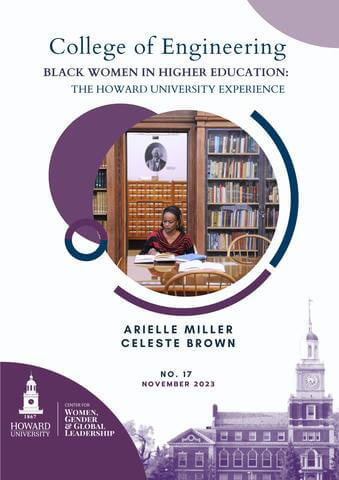Black Women in Higher Education: College of Engineering

AUTHOR: Arielle Miller, Celeste Brown
This report is a chronicle and targeted analysis of Howard University's investment in the Black female engineer, who continues to struggle for equitable placement and advancement in the classroom and workplace. It evaluates past and current gender representation among students, faculty, and leadership within the College of Engineering and Architecture (CEA). Howard started its engineering programs in 1911 but did not boast a female graduate until 1946. Although the programs struggled for another 30 years to achieve consistent levels of female graduates, they have made significant strides. The Chemical Engineering (ChE) and Civil and Environmental Engineering (CEE) Departments have successfully achieved more than 50% female graduates, the highest of all the engineering disciplines. The CEE Department has been led by women for the last 15 years, and 75% of its faculty is female; during this period, the gender gap in the student population narrowed sharply. In contrast, the Electrical and Computer Engineering and Computer Science (EECE) and Mechanical Engineering (ME) Departments have struggled to reach gender parity in their student populations but made recent strides toward improvement. This aligns with national trends in these disciplines. EECE has also been hiring more female tenure-track faculty, and ME is the only other department with a female chair and female professor. Greater study is required within these departments to understand the causal factors for success or the lack thereof in gender representation for both students and faculty.
The percentage of women in engineering at the undergraduate, graduate, and faculty levels has been growing over the last 15 years; however, women still represent less than 30% of the engineering degrees earned and academic faculty (ASEE, 2021; U.S. DOE, 2021; Yoder, 2016). Black and African American women (BAAW) make up the smallest percentage of women in either group at 4% (Berry, 2014; Databytes—By the Numbers: African American Female Faculty, 2019; U.S. DOE, 2021). BAAW are routinely studied as a subset of either Black and African American (BAA) people overall (that is, men and women) or women (Morton, 2020). When the former is studied, the experiences of BAAW can be overshadowed by the overall performance of BAA men (Brown et al., 2016). When the latter is studied, the data skew heavily toward the performance of White women; within studies of women of color, the experiences of BAAW are combined with those of other underrepresented minorities (Brotman & Moore, 2008; Espinosa, 2011; Ong et al., 2018). BAA people make up 70% of the student population and 56% of faculty in historically Black colleges and universities (HBCUs; U.S. DOE, 2021). An evaluation of an HBCU changes the diversity profile for both the student population and faculty, allowing the focus to be placed on the effects of gender disparities in science, technology, engineering, and mathematics (STEM) academic environments.
This report provides a targeted analysis of representation within Howard of the Black female engineer, who continues to struggle for equitable placement and advancement in the classroom and workplace. It evaluates historic and current gender representation among students, faculty, and leadership within the College of Engineering and Architecture (CEA).
